Trophy Package with Frontier Safaris
Are you looking for a package including trophies? Then we have a complete, exciting and great value package for you here!

Highlights
- Hunting district of 27,000 hectares
- Incredibly countryside
- Varied game populations
- Package including trophies
11 days from $6,050
On most hunts you pay for both hunting and accommodation + trophy fees for every single trophy you shoot However we can sense that many hunters are looking for a package that includes it all for a single price. This we can now offer in partnership with Frontier Safaris.
When you hunt with Frontier Safaris you fly to Fort Elizabeth, where you will be met by the outfitter. You will stay in the heart of their hunting district, where you can enjoy outstanding views over the beautiful countryside. Here you will hunt in one, uninterrupted district of some 27,000 ha. with excellent game populations.
Accommodation

Accommodation - Frontier Safaris
The camp is beautifully situated with a view over the bush, and the accommodation takes place in spacious bungalows built from stones from the bush. Each bungalow has its own bathroom, and a great view. There is a total of 16 bungalows, so this place is suitable for bigger group. There is also a swimming pool, if you should need to be cooled down. The meals you have either in the common...
Read moreHunting Area
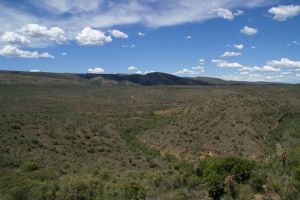
Frontier Safaris
Frontier Safaris´ hunting area is one big area of 27.000 hectares - with open plains, mountains and thick bush. In the hunting area you can hunt a lot of different species, however none of the Big Five, but there is a very big variety of antelopes from the small Blue Duiker to the big Cape Eland. Although it is sold at discount prices, there is nothing lacking with the hunting,...
Read morePartner
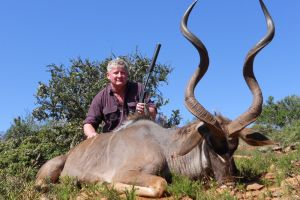
Frontier Safaris
Frontier Safaris arrange hunting in their own area Burchell Game Reserve in the Eastern Cape Province in South Africa. This area is situated about 110 km from the airport in Port Elizabeth (you fly domestic from Johannesburg to Port Elizabeth). Frontier Safaris naturally pick-up and take back their guests from/to Port Elizabeth. Burchell Game Reserve is incredible 27.000 hectares. A really...
Read moreGame
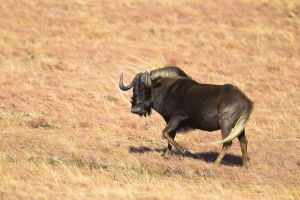
Black Wildebeest
Scientific Name: Connochaetes gnou Subspecies: none Distribution: South Africa ( lives on game farms in Namibia) Habitat: Open grass veld and subdesert steppes. Description: Middle-sized animal of the Gnu-family with a weight of 150 - 170 kg and a shoulder-height of 120 cm. General colour dark brown to jet black and its tail is pure white. A characteristic feature of the White-tailed Gnu is...
Read more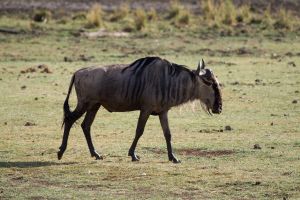
Blue Wildebeest
Videnskabeligt navn: Connochaetes Taurinus Underarter: White-bearded Wildebeest (C.t.mearnsi), Cookson's Wildebeest (C.t.Cooksoni) Udbredelse: Blue Wildebeest: Zimbabwe, Zambia, Mozambique, Sydafrika, Namibia. White-bearded Wildebeest: Tanzania, Kenya. Cookson's Wildebeest: Luangwa Valley i Zambia Levested: Findes i alle former for bushlandskab, men foretrækker åben bush og...
Read more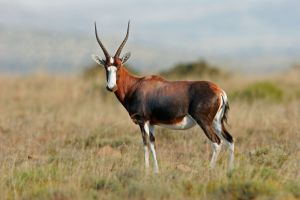
Bontebok/Blesbok
Scientific Name: Damaliscus dorcas Subspecies: Blesbok (Damaliscus d. phillipsi) Distribution: South Africa and Namibia (in game farms) Habitat: Open bush and grassland Description: The two species are here described as one as the difference between them is negligent. (Bontebok is darker in colour, has deeper grooves in its horns, has all white legs and the facial white band is usually...
Read more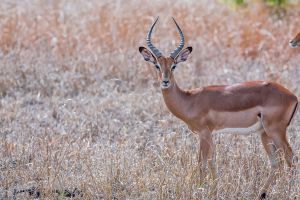
Impala
Scientific Name: Aepyceros melampus Subspecies: East African Impala (Aepyceros m. rendillis) Angola Impala (Aepyceros m. petersi) Distribution: South Africa, Mozambique, Zimbabwe, Botswana, Namibia, Angola, Zambia, Tanzania, Kenya, Uganda and Congo (Zaire) Habitat: Open bush and Acacia savanna Description: The three species are here descriped as on as the difference in appearance is negligent...
Read more
Kudu, East Cape
Scientific Name: Tregelaphus strepsiceros strepsiceros Subspecies: The East Cape Kudu is a subspecies of the Greater Kudu,. Distribution: Only occurs in the East Cape region of South Africa. Habitat: Its preferred habitat is woodland (especially thornveld) close to water, but can occur in semi desert and thick valley bushveld with sufficient food and cover. Description: Large, elegant...
Read more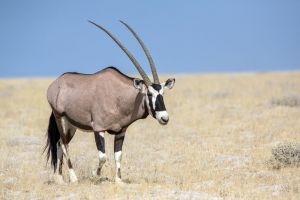
Oryx, Gemsbok
Scientific Name: Oryx gazella gazella Subspecies: Beisa Oryx (Oryx g. beisa) Fringe-eared Oryx (Oryx g. callotis) Distribution: South Africa, Botswana, Namibia and Angola. Habitat: Dry plains and sub-desert. Description: Large antelope with a very compact body. The Gemsbok reaches a weight of 220 kg and a height of around 120 cm. General colour pale fawn grey, with striking patternon head and...
Read more
Warthog
Videnskabeligt navn: Phacochoerus aethiopicus Underarter: Der anerkendes op til 7 underarter, der her beskrives under et. Udbredelse: Hele Afrika syd for Sahara med undtagelse af den vestafrikanske regnskov samt ørken områder i Namibia. Levested: Åben bush og græssletter. Beskrivelse: Mindre griselignende dyr der opnår en vægt på 100 kg og en...
Read moreHunting stories
Jens Ulrik hunts for Kudu
Come with Jens on a kudu hunt to a wild corner of Africa where black rhinos roam among incredible kudus, bushbucks and waterbucks...
Land of giants
I always go hunting with great expectations. To travel without the slightest idea of what adventures are lying ahead is a thrill very similar to the bubbling sensation I used to feel in my stomach the night before my first dozen of birthdays. The certainty that the next day would be great combined with the uncertainty of what would actually happen was excitement in its purest form. The birthdays became predictable and the tickling butterflies on the inside left for good but the childish magic in the joy of expectation remained when it comes to hunting adventures.
In this case, I truly had something to look forward to. The hunting area used by Limpopo Safaris is a huge privately owned nature reserve covering an area of 65,000 hectares. I have been there before. Twice actually and I have come to regard the outfitter Mias Cronje and his lovely wife Bella as good personal friends.
Upon my arrival we test fired the rifle late in the evening in the lights from the car. It was dead on as always. Mias wanted to go kudu hunting early next morning!
Nature paradise
We started our first hunting day with a long walk along the Nzehelele River a tributary to the mighty Limpopo River that forms the areas boundary to Zimbabwe. The landscape was wild and impressive. So was the game populations. Along the deep and rocky riverbed, we saw plenty of waterbuck, bushbuck, kudu, nyala and bush pig. Big crocodiles patrolled the shallow water and a grumpy old black rhino bull demanded our constant attention.
The trophy quality in the area is the result of efficient management. Just 15 years ago this enormous hunting area was a number of worn down cattle farms with very little wild life living in the bush. An investor with a keen interest in nature conservation bought the farms and cleaned up the bush. The area was game fenced and one by one all the indigenous species were acquired and reintroduced into areas where they had been absent for more than a century. Today wild bush has reclaimed the cattle pastures and the area is home to more than 30 huntable species of big game.
All the game populations sustains themselves and there is more than enough room for “difficult” species. Thus the area have strong and growing populations of leopard, spotted and brown hyena, African wild dog, crocodile and all the small wild felines that belong in this part of the world. Only the lion is still missing – due to legislative issues – but it is on its way. To the owners it is all about creating a closed African eco-system – a sanctuary for the wild Africa. Hunting is simply a management tool and a way to finance the whole thing. Quotas are very strict.
Jens the squirrel
On our way back from the morning stalk Mias and Hassan were very cautious. They had no idea of the exact whereabouts of our friend Mr. Rhino and they paused often to spot him before he spotted us. This part of the area is not usually used for hunting guests. I only managed to convince Mias to take me there because I insisted that I was an excellent tree climber and because he did not realize that I am a very poor judge of my own abilities (or lack of same)…
They spotted our heavy buddy on the opposite bank. He was browsing peacefully on dry bushes. We stopped to take photos of the big fellow. He was slowly moving towards us and soon he was within 50 meters. We quietly observed and had already chosen our personal trees should the situation suddenly escalate.
When we felt the breeze against the back of our heads, it was already too late. The hardly noticeable wind had turned to carry our scent directly to the black rhino bull at the bottom of the river. He blinked his beady little eyes raised his head and sniffed the wind. In the next second he exploded in furious rage.
The angry bull snorted as he accelerated from zero to top speed in a couple of leaps. He was headed straight for us. I jumped up and ran the few meters to my tree while Mias calmly distracted the mastodon. I got far in to the tree in no time flat. Actually, I am convinced that I would have been able to climb to the top of a polished flag pole covered in green soap! After a few minutes display of brutal force the bull went back to his own side of the river and we sneaked off to the car.
They say that fear is not real. That is a feeling we choose. I do not know if that is true. I do know that I chose to throw out my underpants when we got back that evening and I did not forget to kiss my Härkila Rhino boots goodnight in appreciation of their tree climbing qualities…
Kudu in sight
We were out early the next morning searching for the strong kudu bulls that are so typical for this area. We had been driving for less than an hour when Hassan spotted two kudu bulls through thick Mopani bush. He could not however get a clear view of their horns. Never the less he had a hunch that they were strong bulls and he convinced Mias to take a closer look.
The bulls were several hundred meters from the car headed towards a steep formation of rocks far from the dirt track we were driving on. 500 meters further ahead Mias turned the Land Cruiser toward the ridge hoping that we would get a chance to see these bulls from the top of the red rocks.
The track went all the way to the top. Mias stopped the diesel engine long before we reached the edge and we silently left the car. We were on a flat plateau high above the plain that stretched from the foot of the cliffs towards the river and its dense green vegetation that made it look like a gigantic green snake moving through the landscape.
Directly below us a pair of young waterbuck bulls got on their feet. They clearly sensed our presence without really realizing the nature of the threat. I took a good look at these magnificent animals through my binoculars as they slowly descended down the side of the cliff sending loose rocks rolling with every step they took.
From the corner of my eye I saw Mias drop to his knees. Instinctively I followed him without knowing why he did it. Mias threw his binoculars before his eyes and starred intensely downhill in a completely different direction than the vanishing waterbucks.
His whispered exited. “Do you see that kudu bull?”
I followed the direction he was looking and there – only about 100 meters down – a giant kudu bull grew out of the shadows beneath a tree that it was feeding on. I quickly got my own set of binoculars in action and a crystal clear image of the magnificent animal appeared before my eyes. My heart skipped a beat or two. This was indeed a sight for sore eyes! The long horns of this bull was curling in deep black turns towards the sky in perfect V-formation. The amber colored tips seemed to be extremely far away from the bases of the horns that were as thick as a grown man’s arms.
“I want you to shoot that bull.... NOW!” Mias was very insisting – and I was not hard to persuade…
You never know!
I crawled back to the car to get the Mauser. As silent as I could I sneaked a round into the chamber and made sure the rifle was not cocked. As fast as I could I crept back to Mias and Hassan who was still starring at the kudu bull below. I moved the last bit like a snake on the rocks and got in position between the others. I was lined up for a pretty easy shot from prone position with – literally – rock steady support.
I turned the Zeiss scope to 10X magnification and lit the fine red center dot for better contrast against the dark silhouette of the bull. My thumb worked the cocking lever without effort and my finger softly found the trigger as I oozed down behind the scope.
He was right at the edge of my sight picture facing us at an angle. I let the glowing red point slide to the center of his chest and let the shot off.
The bull jumped and kicked violently with his hind legs. His left front leg dangled from his body and dark red blood was pumping from the exit wound behind his shoulder. He turned on three legs and ran downhill headed for the thick bush below. The signs were clear – everything looked just fine. But the bull did not stop and drop as soon as we expected him to do so.
He just carried on and was soon at 200 meters distance. I fired a shot through the top of the trees against the dark silhouette. The bullet deflected and went high over the back of the animal. He was now trotting. Another shot – this time at well over 250 meters – failed to penetrate the Mopani bush. But the kudu was slowing down clearly affected by the first shot.
In front of the animal, I saw an opening between two trees. With a single push on the button on my rangefinder Mias measured the distance to 312 meters. I set the ASV+ turret on the scope at 310 meters and could easily send the last bullet in the magazine into the spine of the bull stopping him on the spot.
Strange! Both Mias and I felt sure that the first bullet was perfect and even though the bull was clearly dying it should not have been able to run that far.
Fantastic trophy
Ten minutes later we caught up with the dead bull between the Mopani trees. The huge trophy was by no means less impressive at short distance. This strong old gentleman had seen his share of fighting and he had probably won most of those battles to claim his place in the gene pool
At closer inspection the reason for the longevity of the wounded bull became clear. My first shot had only destroyed one of the bull’s lungs. It was dying when my last bullet struck it to the ground but it would have died within a few meters had I placed my first bullet through the top of the heart.
With a valuable lesson learned and an incredibly beautiful trophy in the salt, we spent the rest of my visit to this spectacular area taking pictures of the abundant wildlife, fishing brim among the crocodiles and – with big grins on our faces – reassuring each other that we tend to give ourselves waaay to little credit…
I saw lots of kudu, bushbuck and nyala with unbelievable trophies and I’ll be very surprised if this area will not dominate the top of the trophy lists for waterbuck within the next decade. I’ve seen several candidates for the top ten with my own eyes. I’ll be back!
MY GEAR
ZEISS: On this trip I am bringing a set of Zeiss Victory HT 8X42 binoculars and a Victory 8X26 PRF rangefinder to complement the rifle scope - a Zeiss Victory HT 2.5-10X50 equipped with the ASV+ ballistic turret. Nothing but the best!
MAUSER: The rifle is a Mauser M03 African PH in .300 Winchester magnum caliber. It turned out to shoot extraordinarily accurate with Norma Oryx 180 gr. ammo. I feel very safe using this particular model as it incorporates a very user friendly hand-cocking devise instead of a conventional safety.
HÄRKILA: I use the strong Oryx pants that fits like a good pair of jeans. A classig safari shirt keeps my skin cool and out of the sun. Both pants and shirt are made from cotton. My feet are comfortably protected by a pair of light Rhino leather boots. A very good choice for hunting in hot weather.
Jens Ulrik i Zulu-land
Black prince of Zululand
Mark Dedekind Safaris south of Pongola in Kwazulu Natal had kindly invited us to hunt red duiker and nyala
– two very typical species for this part of South Africa.
The red duiker was usually the more difficult of the two species to get with only five animals on the yearly quota in the privately owned Mahlalela nature reserve spanning almost 11,000 hectares. We would therefore start our hunt looking after one of these small animals.
Once again I was hunting with my Mauser M03 African PH in .300 Winchester Magnum with a Zeiss Victory HT 2.5-10X on top. Certainly too much gun for an animal weighing only about 12 kg but for the nyala the caliber was suitable and therefore I felt it was a very good all-round rig for this hunt. I simply had to be careful to place the bullet behind the shoulder on the red duiker to give the taxidermist a fair chance.
It took us more than an hour to drive the long way from the lodge over the mountain and down to the bottom of the next valley. On the way we passed an impressive diversity of typical Zululand habitat ranging from dense camel thorn bush over enormous open grass plains at high altitudes to thick jungles filled with red duikers along the rivers at the bottom of the valleys. Freddy Robertson – my experienced PH – knew this enormous area like the back of his hand. On our way to the riverine forests he had explained exactly what the plan was. We would find a nice starting point on the river. From there we would slowly stalk as quietly as possible against the wing pausing frequently to observe. The little red duikers are extremely shy and very alert. If they see the hunters they immediately disappear in the undergrowth.
We moved slowly forward under the canopy. The forest floor was covered in dead branches at crackling dry leaves. I stayed right behind my PH and tried to walk in his pace to make as little noise as possible. The forest was silent as the grave and every little twig that snapped under our foot soles sounded as painfully noisy as a chainsaw in a library. We crossed back and forth over the dried out river bed and stopped at the smallest sound or movement. After less than twenty minutes we spooked the first duiker of the day without any chance of seeing whether it was male or female. Ten minutes later we did it again. Duikers vs. Jens 2-0
Crested guineafowl
Freddy was clearly enjoying this quiet stalk. His smiling enthusiasm was contagious and I was taken by the challenge. Suddenly Freddy froze. A few meters in front of us a small flock of crested guinea fowl was mowing between the bushes. Red duikers are often following these birds as all their scraping reveals lots of delicious food for the duikers. Without a movement he studied the area surrounding the birds resting his binoculars on the shooting sticks. Several long minutes passed before we saw some red movement in the bushes. A red duiker appeared less than 20 meters in front of us. It was constantly moving and energetically wagging its relatively large tail like a happy little dog.
Both male and female red duikers have horns. It is therefore difficult to judge the sex by the look of the head. So Freddy was looking for testicles. Actually for the set of large – or rather huge – testicles that all male duikers carry around considering the relatively small size of these animals. The red duiker in front of us had none. In other words she was a little lady.
The Husband arrives
We both saw the movement in the bush behind the princess. Another duiker had entered the scene. Freddy did not need to look at his private parts to conclude that it was an old male. The thick horns beyond the long hair on his head gave him away. And so did his shameless pursuit of the young female. Freddy carefully put up the shooting sticks and I tried to get in position but the duikers had other plans and moved their activities to another bush during the couple of seconds it took me to get ready. Freddy took a chance and asked me to aim for an opening between the bushes. With a little luck the duikers would appear there. The distance was less than 20 meters. I quietly got in position and waited. I saw a tiny shadow getting closer to the opening. I cocked the action and moved my finger to the trigger. The fine dot of red light in the center of the cross hairs was already lit. Freddy studied the animal intensely through his binoculars. ”Not that one – it’s the female”, he whispered.
I moved my index finger outside the trigger guard. The female stopped in the middle of the opening starring right at us. It was the only time I saw a duiker stand still and the moment didn’t last for more than a second or two. She quickly moved on warning the male who appeared in the same opening just seconds later. ”Shoot!” Freddy said and a shot aimed at the middle of the small silhouette rang out in the forest. The duiker fell down but he immediately got back on his feet and began spinning around for a few seconds before everything was quiet.
”Did you see the tree you clipped?” Freddy asked. I did not. Approximately half way between the muzzle and the duiker the bullet had tarred a small tree apart. Luckily this did not change the course of the bullet substantially. Luck is allowed! The little red duiker was out of it…
What a start, what a hunt! An ancient male with thick horns lay dead on the ground. A beautiful and peculiar animal and a very challenging hunt.
In the afternoon Freddy showed me around in the incredibly beautiful reserve. Zululand’s carrying capacity is among the best in Africa. In this area game is abundant and in very good condition.
Stalking the nyala
We could feel it as we got up early the next morning. The temperature and humidity was rising. We expected a hot day – and we had one! The more than 1,500 nyala in the areas was playing hide and seek in the heat. During a long and sweaty morning stalk we only saw a single female in an area that is usually crawling with nyala. Going back for lunch we had the good fortune to be able to cull an old wildebeest bull in the open grasslands so the mornings hunt was far from fruitless.
In the afternoon we spotted lots of nyala and we stalked a few up and down steep and rocky hill sides. But none of them turned out to be the kind of bulls Freddy was looking for. The late afternoon was sizzling hot with 38 degrees Celsius in the shadow. We drank liters of water.
Our third and last hunting day started out even hotter than the day before. Not a good thing for our nyala hunt. They simply moved to little around to be spotted in the dense areas of bush. Despite some very serious efforts we didn’t manage to get an opportunity to bag a large bull that morning.
We started hunting again early in the afternoon. This was our last chance! Maybe I was not meant to bag a nyala this time around? It was nothing to complain about really. I already had a fantastic hunt, and it wouldn’t be hunting if the outcome was given.
Now or never!
The nyalas was more on the move in the afternoon but still not as much as Freddy would like them to move. We stalked a couple of promising bulls but we were out of luck. The sun was setting behind the mountain as we slowly headed towards the lodge.
Nothing is over before the fat lady sings! Freddy saw two bulls in open bush close to the track. A very young and a very old bull was grazing side by side. We drove a few hundred meters and turned right on another road. A little further ahead Freddy stopped the engine and we quietly left the vehicle. I chambered a round and checked that the action was uncocked and safe. I lit the illuminated center dot in the scope and turned the magnification all the way down to 2.5X.
Our plan was to sneak quietly through the few hundred meters of bush and hopefully find the old bull on the other side. If we bumped into the animals on the way our only option would be a shot at very close range in the thick stuff in front of us.
A light breeze was blowing in our faces. The wind was perfect. We tried to be as silent as possible and moved forward very slowly. A carpet of dry leaves on a bottom of dead branches and twigs bedded in crisp red gravel and loose rocks proved to be quite a challenge to our ambitions of stealth. We looked like Indians in artistic slow motion as we slowly oozed our way through this jungle…
Obstacles
After a little more than a hundred meters ultra-slow advance we reached a dry river bed. A vertical brink of loose dirt with roots sticking out led to a stony bottom four meters below. The opposite brink was equally steep. There was no hope of getting across here!
Freddy starred a little disappointed at the gorge in front of us, but he immediately stalked along the river to try and find a place to cross. Only a few meters further ahead an opportunity presented itself in the shape of a narrow path opened by the nyalas themselves. We crawled under a dead tree and carefully slid down the brink holding on to one of the thick roots on the way. On the other side we repeated the exercise in reverse order.
Freddy carefully raised his head over the edge. Less the 70 meters in front of him the young bull was still grazing peacefully. Freddy slowly looked to the right and there – only 15 meters in front of him – the old bull was feeding towards us! Freddy ducked in slow motion and whispered as silent as he could that I should move around him and kill the bull in front of us. I managed to get around him in slow motion and I raised the rifle as I looked over the top. But we were busted - A nyala does not grow ears the size of a saucer for the fun of it!
Action!
When I cleared the edge I stood face to face with a very alert nyala bull at a distance of 10 meters. We were starring each other directly in the eyes. The moment hardly lasted half a second. The bull threw himself around and ran off at full speed.
”Jump up and see if he stops” Freddy hissed. I was already over the edge!
A second later I saw the fleeing nyala through thick bush at 30 meters – and he saw me! With a powerful jump he turned 90 degrees and started running away from the river at full speed displaying his entire broadside. Instinctively I had thrown the rifle to the shoulder, cocked it and was now following the running bull through the scope. I was on auto-pilot in driven hunt mode! A little further ahead of him I saw an opening in the bush. When the bull passed it my index finger was happy with the sight picture and pulled the trigger. The shot went off and hit the nyala in midair exactly where the neck is attached to the spine.
His lights went out in as the bullet struck him and he collapsed and fell like a sack of potatoes. He was dead before he hit the ground and he raised a big cloud of red dust as he rolled lifeless on the ground. “...or you can do it like that” Freddy cheered loudly behind me. I chambered another round and focused on the bull approximately 60 meters away. His violent kicking left no doubt. The black prince had passed on to the eternal version of Zululand’s lush bush land. I could hear my own pulse and I could feel the sweat running down my body staining my khaki cotton shirt. But I also felt the corners of my mouth getting closer to my ears…
MY GEAR
ZEISS: Victory HT 2.5-10X50 scope.
A very good all-round scope with a versatile zoom range, good light transmission in dark environments and a very fine red center dot in the middle of the reticle. Conquest HD 8X42 binoculars. Mauser: M03 African PH in .300 Win. Mag. A safe, well balanced and very accurate rifle. A good all-round weapon for African plains game. Härkila: Khaki safari shirt and long oryx pants. Both in 100% cotton for maximum coolness. I wear long sleeves and legs because of the sun and the snakes. My feet are very happy with the Rhino leather boots - the perfect safari boot. It’s light, has a good grip and it is very strong!
Prices

The price includes
- Return transfers from Port Elizabeth airport to the hunting district
- 10 days hunting 1:1
- 11 nights accommodation with full board and soft drinks, beer and wine
- Laundry service
- All transport during the hunt
- Skinning og preliminary preparation of the trophies in camp
- Trophy fees from trophy package 1 or 2
The price does not include
- Flights
- Any extra trophy fees for game shot
- Gratuities
- Rifle hire (if necessary) + cartridges
- EU-public liability insurance $ 12.-
- Travel and Cancellation insurance
Trophy Pack 1:
1 Kudu or 1 Nyala
1 Oryx or 1 Burchell's Zebra
1 Blue or 1 Black wildebeest or 1 Hartebeest
1 Blesbuck
1 Warthog or 1 Springbuck
1 Impala
Trophy Pack 2:
1 Kudu or Nyala
1 Oryx or 1 Burchell's Zebra
1 Blue or 1 Black Wildebeest or 1 Hartebeest
1 Impala
1 Blesbuck
1 Duiker
1 Warthog
2 x selection Impala
Choose 3 of the following: Baboon, Jackal, Mt. Reedbuck, White Blesbuck (male or female), Black Springbuck, Springbuck, Warthog or Ostrich
Trophy price list 2025 (USD)
| Aardwolf | 2500 | - | Oribi | 5000 |
| Baboon | 800 | - | Ostrich | 750 |
| Blesbok | 750 | - | Porcupine | 500 |
| Blesbok Copper | 1500 | - | Reedbuck Common | 3000 |
| Blesbok White | 1000 | - | Reedbuck Mountain | 1000 |
| Blesbok Yellow | 1500 | - | Roan | 7500 |
| Blesbok white saddleback | 5000 | Springbuck Black | 1000 | |
| Bontebok | 1750 | Springbuck Cape | 750 | |
| Bushpig | 1000 | - | Springbuck White | 1500 |
| Cape Bushbuck | 1000 | - | Springbuck Copper | 1500 |
| Cape Eland | 3500 | - | Springbuck Kalahari | 1500 |
| Cape Grysbuck | 3000 | - | Springbuck Coffee | 3500 |
| Cape Hartebeest | 1350 | - | Sable under 40" | 5000 |
| Cape Kudu | 2750 | Sable over 40" | 7500 | |
| Cape Lynx | 2000 | Sable over 45" | 10000 | |
| Duiker Blue | 3000 | - | Steenbuck | 500 |
| Duiker Common | 500 | - | Scimitar Oryx | 5000 |
| Giraffe | 3500 | Tsessebe | 3000 | |
| Gemsbok (Oryx) | 1750 | - | Vaal Rhebuck | 3000 |
| Gemsbok Golden | 3000 | - | Warthog | 750 |
| Genet cat | 500 | - | Waterbuck | 2750 |
| Impala | 750 | Wildebeest Black | 1350 | |
| Impala Black | 3000 | - | Wildebeest Blue | 1350 |
| Impala white-flanked | 3500 | Wildebeest Golden | 3000 | |
| Jackal black-backed | 800 | Wildebeest King | 10000 | |
| Klipspringer | 3000 | Wildebeest Royal | 20000 | |
| Lechwe | 3500 | Zebra Burchells | 1750 | |
| Nyala | 2750 |
Exchange Rate
The price show for this tour is for guidance only as fluctuations in the exchange rate may need to be taken into account. The actual price of the tour will be agreed later.



























